The best preparation for tomorrow is doing something today.
When we’ll have no running water, no extra food, no electricity… then we’ll truly understand this old saying… the hard way. Or we can make sure that our houses offer a decent level of protection.
Install a Rain Water Collector or a Rain Filter Barrel
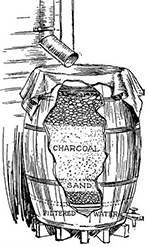 You may choose to store water for gardening or for drinking. For gardening, rainwater is, naturally, best unfiltered. But, for household use, you can make an easy auto-filter using a barrel. Click here if you want to make this 100-year-old filter in a barrel.
You may choose to store water for gardening or for drinking. For gardening, rainwater is, naturally, best unfiltered. But, for household use, you can make an easy auto-filter using a barrel. Click here if you want to make this 100-year-old filter in a barrel.
The filter may be set in the cellar and used only for drinking water. Or it may be used in time of drought for filtering stagnant water, which would otherwise be unpalatable, for the use of stock. This also makes a good cider filter if you want to make vinegar (Read – Making Raw Apple Cider Vinegar at Home).
This will stop you having to spend more money time and energy into a filtration system.
Build a Can Storage Rotation System
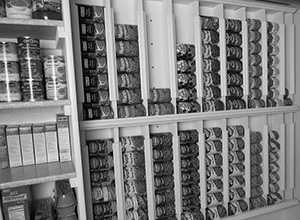 Verify the self-life of your canned goods on a regular basis and learn how to tell when your canned goods become spoiled.
Verify the self-life of your canned goods on a regular basis and learn how to tell when your canned goods become spoiled.
You can verify your canned goods even easier with a can rotator and you’ll always make sure you’re opening the first one to expire (first can in the column – easy).
A can rotator is also a space saver, especially those hanged on the wall.
Disorganization is one of the most common mistakes the new prepper makes. A lack of a real rotation system means the oldest can on hand may not be the first to be use. There are a lot of other woodworking projects that may help you prep a lot more efficient.
Start a Home Defense Plan Including Some Smart Protection Systems
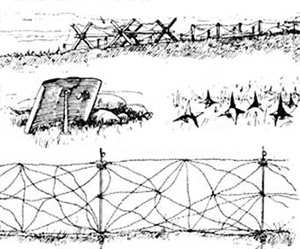 It is generally believed that a good defense position can hold against an enemy with 10 times the numbers of the defender. (same guns)
It is generally believed that a good defense position can hold against an enemy with 10 times the numbers of the defender. (same guns)
Being a single person defending a house, you should have this goal in mind: to withstand the attack of 10 armed street-smart looters. I’m saying “street-smart” because they’ll probably also have a plan… they may surround your house… or maybe they’ll attack at night or when you least expect it… or maybe they’ll set your house on fire, etc.
Without a good defense plan, you’re doomed! Here’s what preppers did during the Baltimore riots (Video Ad).
When setting up your home defenses keep in mind the military term OCOKA which stands for:
- Observation and fields of fire
- Cover and Concealment
- Obstacles
- Key Terrain
- Avenues of Approach
Following these five key principles, you will greatly improve your security and survivability. This is one of the things that I’ve learned from a well-known army officer vet Steve Walker, for whom I have all the respect in the world. Watch his video and learn some fast-tips about protecting your home in time of war or social chaos.
Get Seeds From Your Plants
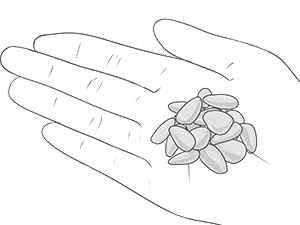 This is a very important technique that needs to be honed and is essential to the continued survival of your plants and garden. Seed collection varies from plant to plant and type of edible vegetable. For example there will be differences in how you preserve and collect seeds from tomatoes, sweet pepper or wheat.
This is a very important technique that needs to be honed and is essential to the continued survival of your plants and garden. Seed collection varies from plant to plant and type of edible vegetable. For example there will be differences in how you preserve and collect seeds from tomatoes, sweet pepper or wheat.
There are too many things to say on this subject. There are a few good articles on the internet if you are interested in post-apocalyptic gardening; no science fiction, just self-sufficiency.
Most of these things can be learned only by reading and practicing. Most of the times reading alone is not enough.
Get to Know Your Neighbors
At the best of times this is a good idea, but of course this will be useful in terms of if you both have skills that can be beneficial to you both (maybe he’s a Medic or a Marine).
Most of the times your neighbor is your friend. In case of a crisis you can start a small community based on mutual interest. Maybe you won’t have to defend your house 360 degrees.
Plus… when it’ll be no hyper active police, and when you’ll be outnumbered… it’s nice to have a “close” friend (literally) ready to help you.
Don’t think he’ll help you? If he’s smart, he’ll better help you… because he’ll be next anyway. In my opinion the community is the key to survival.
Drill a Well or Install a Water Storage Tank
You should make sure to fill up empty clear containers with drinkable water by whichever filtration or purification system works for you (including the barrel filter). For example something like a Brita system or boiling/distilling. In essence he water ready at any time as it is singularly the most important resource that is necessary to promote survival.
Don’t want to drill a wheel? Check out the H2O Dynamo – a device that produces water for your home (and also has a water storage tank).
Build a Root Cellar
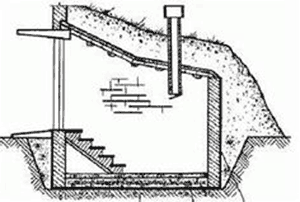 If you don’t have a root cellar yet, then you should consider building one.
If you don’t have a root cellar yet, then you should consider building one.
Root-cellaring is a saving technique for ordinary winter storage of fresh, raw, whole vegetables and fruits that have not been processed to increase their keeping quality.
The root cellar is a way to hold these foods for several months after their normal harvest in a cold, rather moist environment that does not allow them to freeze or to complete their natural cycle to decomposition in the fall.
Understand the elements that make up a Root Cellar which circle around Humidity, Ventilation and temperature. If these element are adhered to, a root cellar can be built by using any viable technique.
There are a variety of building materials that can be used that include stone, concrete cinder blocks, logs and so on.
But recently I’ve discovered an even easier method using earth-bags (and cheaper). If you use earth-bags, please tie them together very tight with barbwire between bags.
Secure Your Living Space From Natural Disasters
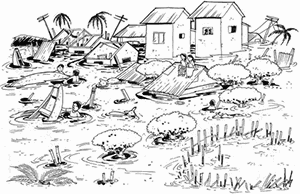 Depending on where you’re living you may want to consider implementing some level of protection against hurricanes, tornadoes, earthquakes, wildfires or floods.
Depending on where you’re living you may want to consider implementing some level of protection against hurricanes, tornadoes, earthquakes, wildfires or floods.
Making sure that tables and sofa’s etc. are nailed down so as to protect the larger objects in the home from damage and from damaging people around them. Making sure that loose objects such as paining’s or vases and similar objects are secured to the best of your ability without making them too much of an eyesore. If you don’t already have one, buy a fire extinguisher.
A secondary stocking space in case your first is compromised. Example: a flood may compromise your supplies in the root cellar, but not the ones in the rooftop.
Make a Faraday Cage
Some people talk about EMP’s like they were talking about science fiction. They look at me like I’m crazy.
Well if I’m nuts, then why does the Army prepares for this? Recently, NORAD has moved its communication equipment back to its nuclear Cold War-era bunker under the Cheyenne Mountain because this base is EMP hardened.
To avoid a total collapse every American should have some EMP hardened equipment or at least a Faraday Cage to protect the most important survival electronics. Here are some Faraday cages that you an make at home… and the most important electronics that you should keep safe, in the cage.
Make Room in Your Garage to Store Gas
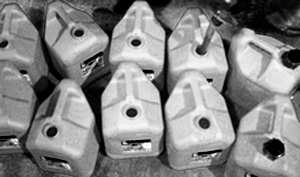 Another essential is to keep a few gallons of gasoline in the garage or anywhere away from the house and from the sun.
Another essential is to keep a few gallons of gasoline in the garage or anywhere away from the house and from the sun.
You’ll power a generator or your car… either way, fuel is an INVESTMENT! Gas price will rise for sure.
Just make sure that the container is safe for this and that it keeps the gas airtight. For example plastic containers that seal well are always good ideas.
Install a Back Up Power Source
 The mechanism that you want to install depends on where you live. You can use solar, wind, water power or a generator.
The mechanism that you want to install depends on where you live. You can use solar, wind, water power or a generator.
Don’t know what’s financially best for you? Read this article and find out.
If you can use solar panels for part or all of your electrical needs it would go a long way towards making you completely self-sufficient and living with a sufficient amount of comforts in the form off electricity.
With sparing use it is possible to live completely off of solar energy but more than likely it will be a combination of eatery and solar power that will allow you to operate your electrical equipment.
Related: DIY Back-up Generator (Video Ad)
Build a Hideout For Your Valuables or For Your Family
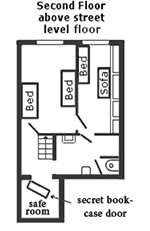 Cash and gold are a good idea to have but it is necessary to ensure that these items area safe. Make sure that valuables are in a safe or a storage facility that is difficult to reach into as these items while trying to survive become ever more important.
Cash and gold are a good idea to have but it is necessary to ensure that these items area safe. Make sure that valuables are in a safe or a storage facility that is difficult to reach into as these items while trying to survive become ever more important.
If you have a useless space in your house, you may want to turn it into a super hideout (see picture). Click here if you’re interested in building a secret bookcase door.
If your family has a food storage of 2 months or more, you might want to consider the potential risks associated with others knowing about it.
Or the safe room could be your root cellar. The weak point on that structure would be the ventilation system. In order to conceal your root cellar, you’ll probably need to hide your exit pipe or to extend your ventilation system up through the walls of your house and to the roof, thus appearing as part of your house’s vents and pipes, hiding in plain sight.
Build a Medical Survival Kit
First Aid Kits are one of those preparedness items that people often neglect. Unfortunately, they don’t seem to get the same attention that things like survival knives, guns and bug out bags get (Source). But if you think about it, in a crisis… diseases are the no 1 killer.
Antibiotics, penicillin and a few other essentials like iodine, gauzes and bandages will go a long way to ensure that inevitable accidents or simple colds do not become fatal. Here are the only 4 antibiotics that you you’ll need when SHTF.
Splints, scissors and painkillers would also be of good use as one never know what sort of ailments or accidents will happen in the course of survival.
Build a Fireplace
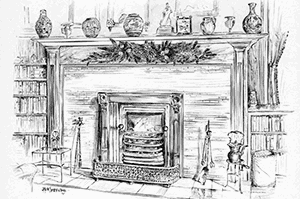 Why? Just so you can provide heat in a low-tech fashion, and because you don’t want to rely entirely on fuel, grid or other generators that may fail in a crisis.
Why? Just so you can provide heat in a low-tech fashion, and because you don’t want to rely entirely on fuel, grid or other generators that may fail in a crisis.
Instead, anybody can cut and burn woods… just like our ancestors did.
Plus… it also provides light in one room.
Plus… you can cook in-house when there’ll be no electricity.
Plus … it’s a cool place to sit by in the winter.
Start a Small Medicinal Garden
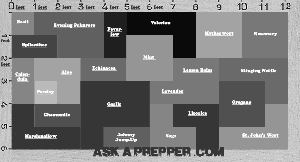 Wouldn’t it be nice if you could walk out into your backyard and find the medicine you need growing right there, ready to be picked and used to treat someone in your family?
Wouldn’t it be nice if you could walk out into your backyard and find the medicine you need growing right there, ready to be picked and used to treat someone in your family?
A few days ago I made a 72 square-feet medicinal garden plan (see picture) that you might want to see.
All plants have different therapeutic actions, such as anti-inflammatory, fighting fever, for heart failure, a sedative, etc… basically for anything.
Preserve Part of The Food That You Produce
 Drying, cooling, freezing, salting, smoking, pickling, canning… you have a lot of methods to choose from.
Drying, cooling, freezing, salting, smoking, pickling, canning… you have a lot of methods to choose from.
Recently drying has become more popular, but let’s not forget about a few old methods like burring food in a barrel (see picture) or turning meat into Pemmican balls.
If you have a dehydrator, you are likely already putting it to work making dried eggs, fruits, meat, etc.
Isn’t it nice when you know how what goes into your food? Maybe more importantly what doesn’t go into it, such as chemicals.
Insulate Your Attic and Turn It Into a Place To Keep Supplies
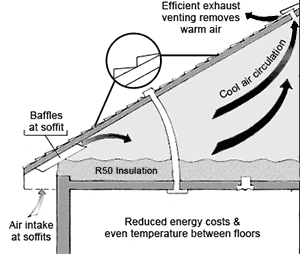 More heating and cooling goes through the roof in most improperly insulated homes than you’d think!
More heating and cooling goes through the roof in most improperly insulated homes than you’d think!
An efficient exhaust venting at the top of the roof (see picture) will remove the warm air in summer keeping a cool, dry and dark… just perfect for storing supplies.
And in winter it reduces the humidity by stopping the condense on inner walls (caused by the snow on the roof). Here are two pictures that explain this better than me: in the summer and in the winter.
Generally, a well insulated house will reduce reliance on both air conditioning and heating systems.
Plus… poor insulation can cause your power bill to be higher than it needs to be, so taking the time to ensure your home is properly insulated can save you some money. Think of this as an investment. Yes you’ll spend a few bucks today, but on the long run you’ll get them back and make a profit. Seal all air leaks… especially in autumn, just before winter. You can also install door sweeps.
Credit to C. Davis
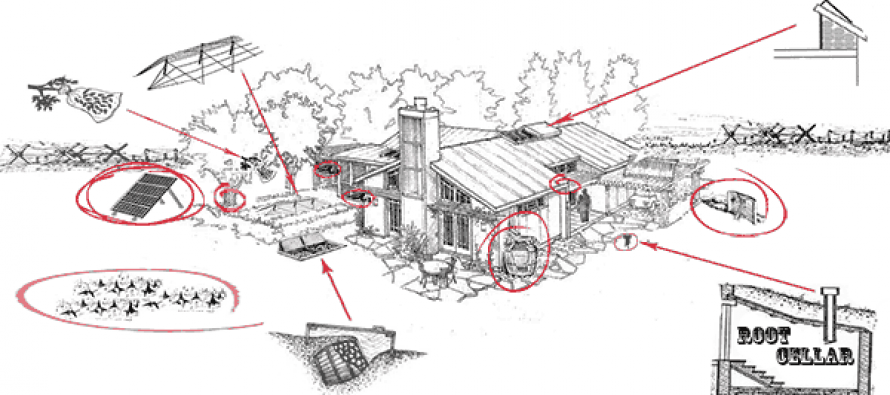

No comments:
Post a Comment